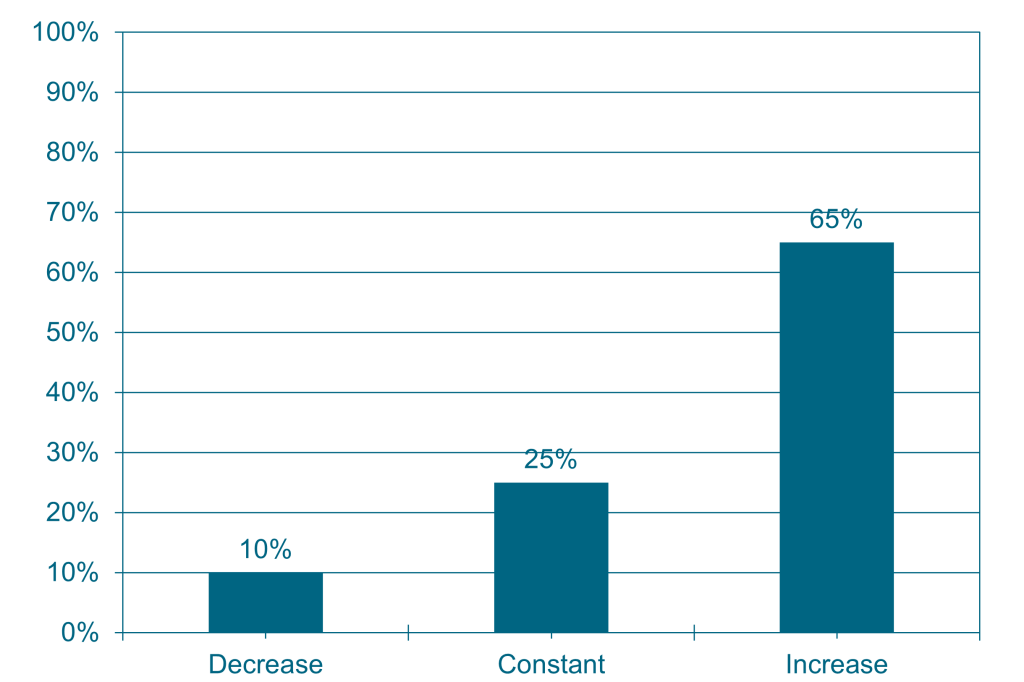The Additive Manufacturing working group of the German Mechanical Engineering Industry Association (VDMA) has published the results of its fall 2024 3D printing survey.
The survey of member companies reflects optimism within the additive manufacturing sector, with most respondents sharing a positive outlook for the future of 3D printing.
This positivity comes amid “an extremely difficult market environment,” according to Dr. Markus Heering, Managing Director of the VDMA’s Additive Manufacturing Working Group. He added that 3D printing companies are “demonstrating remarkable stability,” with just 35% of those surveyed reporting fewer sales in fall 2024.
The expanding influence of Chinese companies was also evident in the responses, with 43% of respondents viewing themselves as directly competing with additive manufacturing providers from China.
This reflects broader market trends, with CONTEXT’s Q2 2024 report emphasizing the ‘explosive’ growth of Chinese desktop 3D printer manufacturers such as Bambu Lab and Creality. Professional users are increasingly adopting cheaper, Chinese-made models which offer similar features to high-end systems.
While the survey’s outlook is largely positive, VDMA reports that the general economic situation has caused most companies to delay investments. Respondents point to targeting new applications, expanding into novel markets and accelerating R&D as key to igniting renewed growth.

3D printing to continue growth trajectory?
Based in Frankfurt, the VDMA boasts 3,400 members and claims to be the largest network organization for mechanical engineering in Germany and Europe.
Its Additive Manufacturing Working Group focuses on industrial 3D printing and features around 180 companies that represent the entire additive manufacturing process chain. This spans 3D printer manufacturers, technology and material suppliers, software developers, post-processing specialists, researchers, consultants, and users.
From their responses, these members largely share a positive outlook for 3D printing over the next two years, with 65% of respondents anticipating growth within their domestic market. While 58% expect an increase in exports, this figure has decreased from 68% in the spring survey.
The VDMA’s members largely view the EU as their most significant export region, garnering almost three-quarters of responses. This was followed by the United States and non-EU European countries.
China and other Asian nations are also identified as fertile sales markets, identified by 10% and 15% of responding companies, respectively. While Chinese manufacturers have generated attention within the VDMA’s working group, 36% of respondents still identified US companies as offering the stiffest competition.
Despite a largely positive outlook, the survey reflects the negative impact of the current economic situation of additive manufacturing. Only 27% of respondents plan to increase their investment in the coming year.
How can further investment in 3D printing be generated? 68% of the companies believe new applications will have the largest positive impact on the industry, with the targeting of new markets identified by 52% of respondents. Additionally, one in five hope that increased R&D and marketing will have a positive impact throughout the remainder of 2024.

The VDMA on the future of 3D printing
Looking to the future, Heering argues that key players need to work on lowering the cost of 3D printing to increase its competitiveness. He highlighted the need to develop new technologies for series production applications, with automation set to be central to achieving this. According to Heering, 3D printer reproducibility and stability are also vital to promoting the broader adoption of additive manufacturing.
The VDMA believes its working group will play a significant role in achieving these goals. The organization reportedly facilitates the free exchange of ideas, challenges, solutions, and best practices across all 3D printing processes and materials. The group is also said to offer valuable suggestions and points of contact for members.
“The exchange along the additive process chains, in which all participants share their perspectives, experiences and challenges, leads to a deeper understanding of the tasks at hand and raises awareness of the need for development along the entire chain,” added Heering.
Industry experts identify 3D printing trends
The Wohlers Report 2024 reflected some of the same trends seen in the VDMA’s latest survey. Sharing data provided by 245 3D printing organizations and responses from 100 global 3D printing experts, the report anticipates increasing demand for series production and the emergence of new applications. This is set to be driven by faster 3D printer speeds and lower cost-per-part.
Notably, the latest Wohlers Report claims the 3D printing industry has grown by 11.1% to an estimated valuation of $20.035 billion. However, this figure is at odds with those provided by other organizations. For instance, market intelligence firm AMPOWER estimated a 3D printing market valuation of €10 million for 2023.
Elsewhere, first-time exhibitors to the International Manufacturing Technology Show (IMTS) 2024 recently provided insights on the key trends at the show, and how 3D printing is shaping the future of manufacturing.
Katelyn Lennon from Würth Additive Group highlighted the growing interest in 3D printing applications to optimize factory floor operations, such as tooling and fixtures. Elsewhere, Linde Advanced Material Technologies’ Luiza Faro pointed to growing attention towards the development of custom materials tailored for specific applications. An increased emphasis on cost and process efficiency was identified by Violetta Nespolo from Caracol.
Want to share insights on key industry trends and the future 3D printing? Register now to be included in the 2025 3D Printing Industry Executive Survey.
What does the future of 3D printing hold?
What near-term 3D printing trends have been highlighted by industry experts?
Subscribe to the 3D Printing Industry newsletter to keep up with the latest 3D printing news.
You can also follow us on Twitter, like our Facebook page, and subscribe to the 3D Printing Industry Youtube channel to access more exclusive content.
Featured image shows the VDMA’s Frankfurt-based offices. Photo via the VDMA.

